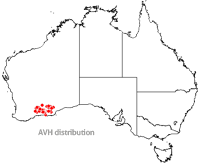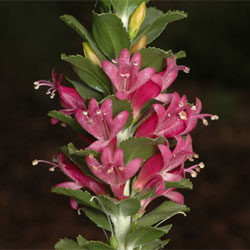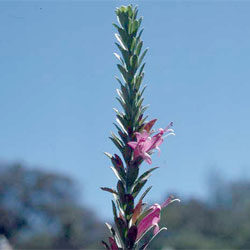Eremophila calorhabdos
Red Rod Emu Bush, Native Fuchsia
 Eremophila calorhabdos is an attractive flowering shrub of the Scrophulariaceae family. This plant is also known by the common names of Red Rod Emu Bush, Native Fuchsia and Spiked Eremophila.
Eremophila calorhabdos is an attractive flowering shrub of the Scrophulariaceae family. This plant is also known by the common names of Red Rod Emu Bush, Native Fuchsia and Spiked Eremophila.
The species is native to Western Australia where it has a restricted distribution centred around Esperance. However it is locally widespread, being found on light sandy soils in open shrub-mallee associations in the Coolgardie, Roe and Eyre districts. It is especially common in recently burnt areas (1-2 years after fire) as a result of high seed germination after fire, indicating it is a fire responsive plant. It is also common in disturbed sites, responding to light grading.
E. calorhabdos has an unusual growth form for an eremophila, making it a favourable plant for use in horticulture. It generally grows as an erect, spindly shrub of 1-4m tall, sending up several upright rods from a single stem. However, if pruned from an early stage it can form a denser shrub. It has grey-green leaves up to 25mm long and 8mm wide which are elliptic to oblong in shape with a serrated edge. The branches may be densely covered with short hairs.
E. carlorhabdos produces prolific floral displays mainly between October and December; however flowering has been recorded from August to May. Flowering can be sporadic, and the plant may bloom for many months in a good season with mild weather and regular rainfall. Flowers are tubular in shape, up to 3 cm in length and range in colour from red to pink and occasionally purple. The fruit are dry, about 7 x 5mm in size, ovoid and laterally compressed in shape and have 2 prominent horn-like ribs on each side.
This species is an ideal garden plant due to its unusual but striking growth form and so makes a stunning feature plant. It can also be trimmed into hedges if pruned from an early stage and will grow in confined areas or against walls. It also makes an excellent cut flower plant and attracts birds as it provides a food source for nectar feeders.
E. calrohabdos is highly drought tolerant, will grow in hot, dry sites and requires no supplementary water. It is relatively frost tolerant, although in colder locations such as Canberra, it requires a warm location and does not perform well under the combination of cold conditions and wet ‘feet’. This plant will grow in loamy or sandy soils however it requires good drainage and so does not do particularly well in the heavy soils of the east coast. It will grow well in a container or built up garden bed with well drained soils. Due to the top heavy nature of the plant, it can become unstable in strong winds and so requires a sheltered position. It may be subject to attack by aphids and in temperate climates, grey mould.
E. calorhabdos is primarily cultivated from cuttings, which strike relatively easily. Given the drainage problems which arise with this plant, it is sometimes grafted onto Myoporum species which results in a much more vigorous shrub. Given the proliferation after fire, fire may be used as a tool to initiate germination from seed.
Text by Laura Williams (2012 Student Botanical Intern
Name Meaning: Eremophila calorhabdosEremophila — from the Greek erema meaning 'desert' and phila meaning 'loving' calorhabdos — 'beautiful wand', referring to the distinctive erect, wand like branches resembling plants in the Calorhabdos genus. |
References
Boschen, N., Goods, M., Wait, R. (2008) Australia's Eremophilas: changing gardens for a changing climate. Bloomings Books Pty Ltd, Melbourne.
Brown, A. & Butrchell, B. (2011) A field guide to the Eremophilas of Western Australia. Simon Neville Publications.
Chinnock, R.J. (2007) Eremophilas and allied genera: a monograph of the Myoporaceae. Rosenberg Publishing Pty Ltd, New South Wales.
Elliot, W. R. & Jones, D. L. (1984) Encyclopaedia of Australian plants suitable for cultivation. Vol. 3. Lothian, Melbourne.
Archer, W. (2010) Eremophila calorhabdos - Red Rod, Esperance Wildflowers. http://esperancewildflowers.blogspot.com.au/2010/05/eremophila-calorhabdos-red-rod.html. Accessed 9th February 2012.
Percival, J. (2012) Personal Communication. Horticulturist, National Botanic Gardens
Western Australian Herbarium, Department of Environment and Conservation. http://florabase.dec.wa.gov.au/help/copyright. Accessed on 10th February 2012.
![An Australian Government Initiative [logo]](/images/austgovt_brown_90px.gif)



